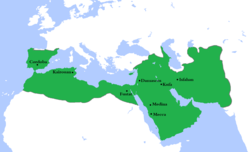Omayyads
| Umayyad Caliphate | ||||||||||||||||||||||||
| ٱلْخِلافَةُ ٱلأُمَوِيَّة | ||||||||||||||||||||||||
|
||||||||||||||||||||||||
|
The Umayyad Caliphate at its greatest extent
|
||||||||||||||||||||||||
| Capital |
Damascus (661–744) Harran (744–750) |
|||||||||||||||||||||||
| Capital-in-exile |
Córdoba (756–1031) |
|||||||||||||||||||||||
| Languages | Arabic (official) – Coptic, Greek, Latin, Persian (official in certain regions until the reign of Abd al-Malik) – Aramaic, Armenian, Berber languages, African Romance, Mozarabic, Sindhi, Georgian, Prakrit | |||||||||||||||||||||||
| Religion | Sunni Islam | |||||||||||||||||||||||
| Government | Caliphate | |||||||||||||||||||||||
| Caliph | ||||||||||||||||||||||||
| • | 661–680 | Muawiya I | ||||||||||||||||||||||
| • | 743–744 | Al-Walid II | ||||||||||||||||||||||
| • | 744–750 | Marwan II | ||||||||||||||||||||||
| History | ||||||||||||||||||||||||
| • | Muawiya becomes Caliph | estimated from 660 to 665 | ||||||||||||||||||||||
| • | Defeat and death of Marwan II by the Abbasids | 750 | ||||||||||||||||||||||
| Area | ||||||||||||||||||||||||
| • | AD 720 | 11,100,000 km2 (4,300,000 sq mi) | ||||||||||||||||||||||
| Population | ||||||||||||||||||||||||
| • | 750 est. | 34,000,000 | ||||||||||||||||||||||
| Currency | Gold dinar and dirham | |||||||||||||||||||||||
|
||||||||||||||||||||||||
The Umayyad Caliphate (Arabic: ٱلْخِلافَةُ ٱلأُمَوِيَّة, trans. Al-Khilāfatu al-ʾUmawiyyah), also spelt Omayyad, was the second of the four major caliphates established after the death of Muhammad. This caliphate was centered on the Umayyad dynasty (Arabic: ٱلأُمَوِيُّون, al-ʾUmawiyyūn, or بَنُو أُمَيَّة, Banū ʾUmayya, "Sons of Umayya"), hailing from Mecca. An Umayyad member had previously come to power as the third caliph, Uthman ibn Affan (r. 644–656), but the Umayyad Caliphate was established by Muawiya ibn Abi Sufyan, long-time governor of Syria, after the end of the First Muslim Civil War in AD 661. Syria remained the Umayyads' main power base thereafter, and Damascus was their capital.
The Umayyads continued the Muslim conquests, incorporating the Caucasus, Transoxiana, Sindh, the Maghreb and the Iberian Peninsula (Al-Andalus) into the Muslim world. At its greatest extent, the Umayyad Caliphate covered 11,100,000 km2 (4,300,000 sq mi) and 62 million people (29% of the world's population), making it one of the largest empires in history in both area and proportion of the world's population.
The Umayyad Caliphate was secular by nature. At the time, the Umayyad taxation and administrative practice were perceived as unjust by some Muslims. The Christian and Jewish population still had autonomy; their judicial matters were dealt with in accordance with their own laws and by their own religious heads or their appointees, although they did pay a poll tax for policing to the central state. Muhammad had stated explicitly during his lifetime that Abrahamic religious groups (still a majority in times of the Umayyad Caliphate) should be allowed to practice their own religion, provided that they paid the jizya taxation. The welfare state of both the Muslim and the non-Muslim poor started by Umar ibn al Khattab had also continued, financed by the Zakat tax levied only on Muslims.
...
Wikipedia

